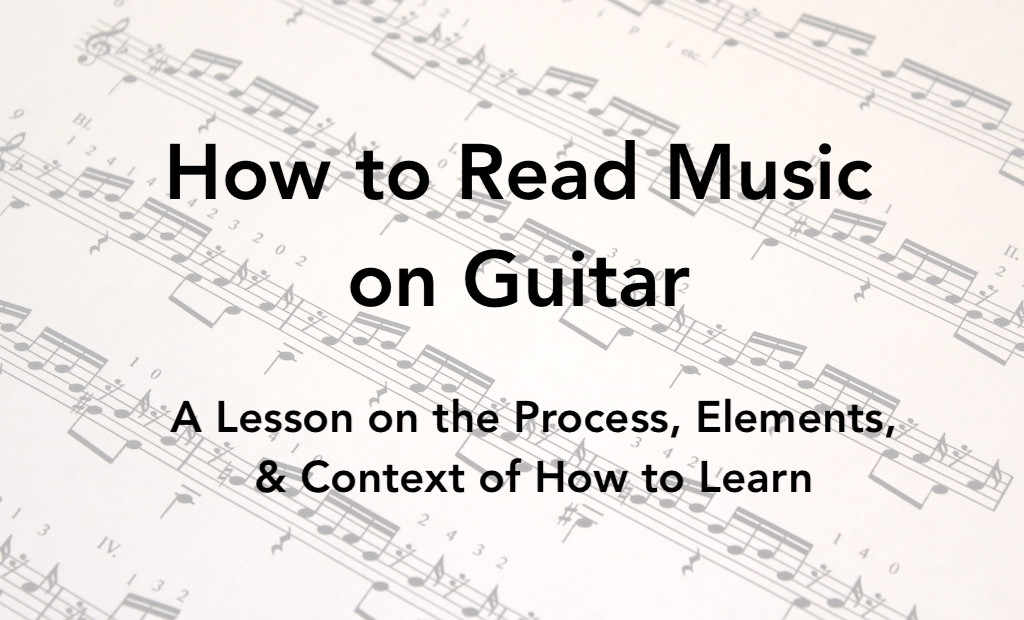
How to Read Sheet Music on Classical Guitar – This is a lesson on how to go about learning to read sheet music notation from beginner to advanced levels. It’s a lesson on the process and elements as well as the musical context. Learning to read sheet music is easy and extremely rewarding but it’s a long process and can be quite overwhelming for beginners. The important thing is to approach it in steps that are appropriate to your level. Although my site is about classical guitar I think you’ll find the information relatable to other styles and instruments.
Want to start reading right now and skip this article? See my page on How to Use my Educational Series of books with videos to start reading music right now at a level appropriate to your experience. If this is your first time reading but you already have guitar experience I suggestion starting at the very beginning and integrate it into beginning of your practice session in small amounts.
Why learn to read music notation? Music notation is a universal language that allows us to communicate with other musicians of all instruments, interpret a composer’s music accurately, and is a key to understanding music theory and analysis.
The downsides of reading tablature – Guitar tablature or tab is great for some things but it really doesn’t have the benefits of reading music notation. Tab is like a secret language that only guitarists can understand. With tab we can’t communicate with other musicians or composers. Tab also has no relation to music theory since it is just a diagram of where to play things on guitar. That said, tab can be fun for things like learning your favourite rock riff right away and some people find it helpful when out of their element. It really just depends on what your goals are and how far you want to go in the learning process.
Sight-Reading Tips – Learning to sight-read music is very similar to learning to read music in general but I have a dedicated article on it here: How to Sight-Read Music on Guitar.
Starting the Process of Learning to Read Music
Find a good method book – Working through a method book will make learning to read music much more enjoyable and manageable. There is way too much information at first so having it presented in small progressive chunks is much better. With my free beginner method book with videos you get very little information to start because you need to start playing musically and developing your listening skills in connection with music notation. At the beginner stage, methods might just show you how to read notes on guitar, that is, where notes are located but at more advanced levels methods will teach you connections between scales and reading in positions of the fretboard as well as how to relate music theory to the guitar.
Working with a teacher and other musicians – Yes, you need to learn to read music notation but you’ll also need to be guided through the process and learn to play musically and naturally. Students need to learn how to interpret the notation into beautiful music. You can gather up a bunch of information on reading music but you don’t want to sound like a robot when you play. We are talking about learning an art form here so it’s not all about gaining the strict technical information. This is best done with in-person lessons but these days you can also use videos as with my free beginner method book that has YouTube videos for each page. Playing duets and chamber music can also help students realize that reading music is only part of the process of interpreting it.
Practice reading music every practice session – When I teach crossover students with previous guitar experience but no reading skills I usually suggest they start with only 5 minutes a day of easy reading and then continue with their normal routine. As their skills develop they can increase the amount of time but it takes a lot of concentration at first and I want students to continue to enjoy music and avoid frustration. It’s similar to learning to read language. When you first start reading language you spell words out one letter at a time but now you just look at words or groups of words at a time an it’s easy for you. Ease into it, especially if you are a crossover student who is used to practicing for hours. Eventually you’ll easily be able to handle reading for your entire session. The art of sight-reading is a whole other topic and that is a lifelong endeavour and very enjoyable.
Enjoy working it out (not getting hooked on an alternative) – Lots of students want to get to playing music right away without this extra step of learning to read music. That is why I get my students reading at a very basic level from the very first lesson. As their guitar technique develops so can their reading skills. If you get hooked on reading tablature you might not have the patience to go back. That said, as you gain more reading and theory skills you will come to enjoy working out the reading of the music. This can encompass sight-reading skills, interpretation of the composer’s intentions, theory analysis and more. Working it out is part of the fun.
Technique on your instrument – To read at higher levels you’ll need technique skills on your instrument in order to actually play the music. They really go hand in hand. You can check out my Classical Guitar Technique book to learn more.
Music theory and musicianship – Once you have learned some basics about reading music on guitar you can enter the fascinating world of music theory. Some of this will be covered in your guitar methods but the real solid information comes from pure theory or musicianship books. Theory teaches you how music works and how it relates to historical and contemporary compositions. Musicianship is the skills involved in music from listening, hearing what you see, executing rhythms, and more. Knowing some music theory will also improve your reading skills. Seeing intervals, chord qualities and more just by looking at the page will instantly translate into hand and finger shapes on the guitar. You’ll be able to correct mistakes before they happen on the fretboard. Instead of picking through each note of a chord and trying to find it on the guitar you’ll be able to just see that it is a major chord and make the shape instantly on the guitar. This is particularly helpful in sight-reading on the guitar. You can check out my recommended Music Theory Books.
Review and Practical Tips for Reading Music on Guitar
Before I discuss reading for beginner to advanced levels, here’s a review and some extra practical tips to apply right now in your practice sessions.
- Use methods and materials appropriate to your level of reading skill.
- Engage with teachers and other musicians so you gain an understanding of how to interpret music notation. Online videos can help too.
- Avoid mistakes by building good habits such as first looking over the time signature, key signature, scanning the piece, and playing very slowly when you are first learning a piece.
- Use a metronome, make sure you are able to play the rhythms correctly and in-time before adding a bunch of rubato or liberties.
- Study a music theory book to make sure you haven’t missed or forgotten anything.
- Read along with recordings or videos without the guitar. This is an excellent way to learn how pros interpret music notation without you having to worry about the guitar playing.
- Do it everyday if possible but only for as long as you can concentrate and enjoy yourself. You can break up the reading in your sessions by alternating materials.
Reading Sheet Music for Absolute Beginners
Learn to Read Music and Being Musical – As an absolute beginner the most important thing is to enjoy playing and not worry about understanding everything related to reading music. There is too much information when you start so you have to start very simply and naturally. In my free beginner guitar method with videos you start playing right away and reading with very little information. The sheet music is just a loose guide when you begin. This can bother the inquisitive minded adult on occasion but there is good reason for it. Reading sheet music is only a way of communicating the music, it is not music itself. Students need to listen and learn to be musical in a natural way. This is done by imitating their teacher, a performing artist, or following video lessons as with my method. Listening and interpretation of the sheet music is almost more important than the technical act of being able to read little black dots on a page.
Main tips for beginners – Keep it simple by using material that is appropriate to your level. Don’t worry about knowing everything all at once, find a reputable method and use it starting from the absolute beginner stage. If you have previous experience with guitar start reading sheet music for only 5 minutes a day and combine it with the goal of playing beautifully and relaxed.
Materials
Classical Guitar Method Volume 1, 100 pages with video lessons
Reading Music for Late-Beginners
At the late-beginner level the student can start making more connections between music theory and the instrument. In my Volume 2 method the student starts playing scales, arpeggios, chords, and repertoire in designated keys so they learn to connect the idea of playing in a key and knowing the scales and chords in relation to a piece in the same key. This is not learning about theory strictly but just getting used to some ideas and playing guitar within theoretical concepts.
My Materials for Classical Guitar
Classical Guitar Method Volume 2, 89 pages, Sheet Music Only
Reading Music for Early-Intermediates
At the early-intermediate stage it’s time to start getting organized but also not get stuck in information overload either. That is why my methods go into the style of repertoire lesson books which integrate the information directly connected to pieces of music. They expand their knowledge of the fretboard and reading naturally in areas directly connected to their pieces of music. In my experience, students at this level don’t benefit from, or can even handle, a deep dive into a comprehensive study of theory or the entire fretboard. They just learn things as they learn repertoire and continue to enjoy themselves and build skills and enthusiasm.
I will often start a simple music theory book at this stage without worrying too much about how much they progress through it. But getting some theory knowledge into them might clear up some issues or gaps in learning. You can check out my recommended Music Theory Books.
My Materials for Classical Guitar
Classical Guitar Repertoire Lessons Grade 1
Classical Guitar Repertoire Lessons Grade 2
Classical Guitar Repertoire Lessons Grade 3
Classical Guitar Technique – You need technique skills to read music at higher levels.
Other publishers
Sight Reading for the Classical Guitar (2 books) by Robert Benedict – Excellent books. Form, phrasing, dynamics, skills. Maybe just start with book one. These cover a variety of textures and discuss form and other topics. Without videos or audio but great for sight reading practice as they cover a lot of ground in a relatively short book.
Other beginner method books. A great and totally amazing thing to do that most student don’t do is go buy a bunch of other method books. If you are using my method books you’ll want to continue to build on your progress and using another beginner method for sight reading is great practice. Plus you’ll hear the same info from a different teacher. For example, the Hal Leonard classical guitar method is good extra reading practice. Or choose a jazz or popular style method with music notation to gain some skills outside of the classical guitar.
Reading Sheet Music for Intermediates
The intermediate stage is just a deeper and more comprehensive study than the early-intermediate. There is still plenty of actual playing techniques to learn on the guitar so reading comes along with that step by step. Music theory is now getting more important. It helps to know about form and structure and analysis. Plus, it will help to understand how knowing some music theory will improve your reading skills. Seeing intervals, chord qualities and more just by looking at the page will instantly translate into hand and finger shapes on the guitar. You can check out my recommended Music Theory Books.
My Materials for Classical Guitar
Classical Guitar Repertoire Lessons Grade 4
Classical Guitar Repertoire Lessons Grade 5
Classical Guitar Repertoire Lessons Grade 6
Reading at more advanced levels
At the late-intermediate level the student should start making thorough and comprehensive connection between music theory, scales, harmony and the fretboard. This will involve both theory work away from the guitar and direct guitar practice as well.
Example of a material and type of study – One excellent book and example is the Scale Pattern Studies by Aaron Shearer. This is a very comprehensive book about scales and melodic sight reading. Over the course of 279 pages you learn scale patterns in every key and then read exercises using those scale patterns. It’s a direct connection between the scale pattern and the reading skills. I do this in my grade repertoire books a bit but this book does it in every key and in every position of the guitar. Most students can’t handle this book at the beginner level even though it would be good for them. But late-intermediate students can start integrating it into their practice sessions.
The above example can be done with many many topics from triads, chords, intervals, harmonic progressions, counterpoint, and more. So many books and topics but so little time! That is why music is a lifelong study.
An Overlooked Aspect – I learned to read music when I was younger and taking lessons. But later in life I attended jazz college for awhile before returning to study classical guitar and make it my profession. At jazz college I learned all my scale and chord knowledge away from sheet music and when I returned to classical music and books such as Shearer’s I had no trouble digesting the material. So branch out a bit and expand your knowledge base.
Start Reading Music Now
See my page on How to Use my Educational Series of books with videos to start reading music right now at a level appropriate to your experience. If this is your first time reading but you already have guitar experience I suggestion starting at the very beginning and integrate it into beginning of your practice session in small amounts.

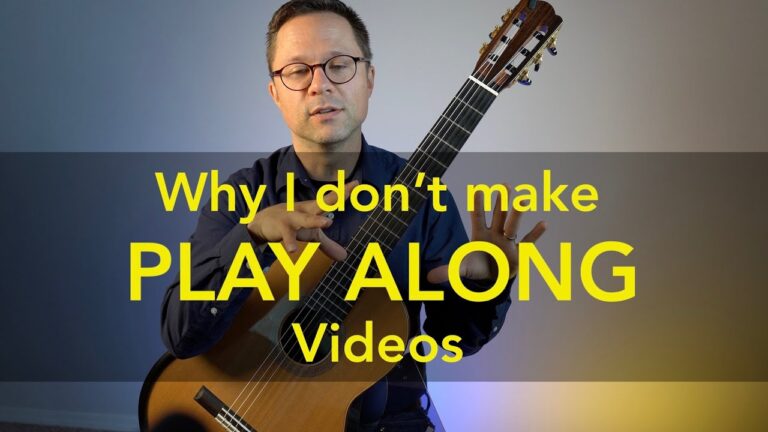
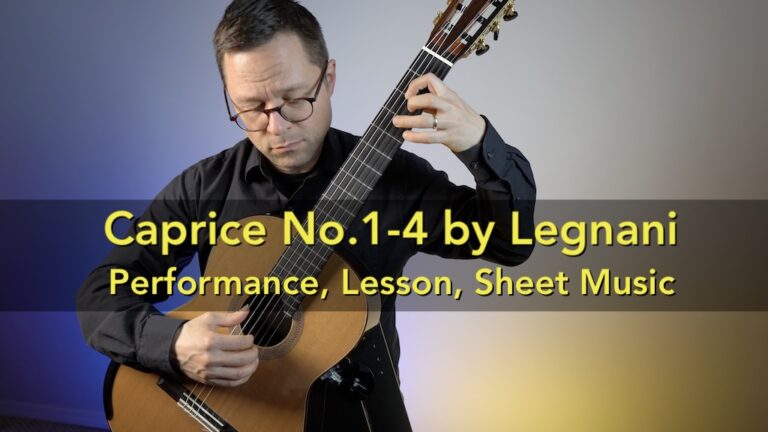
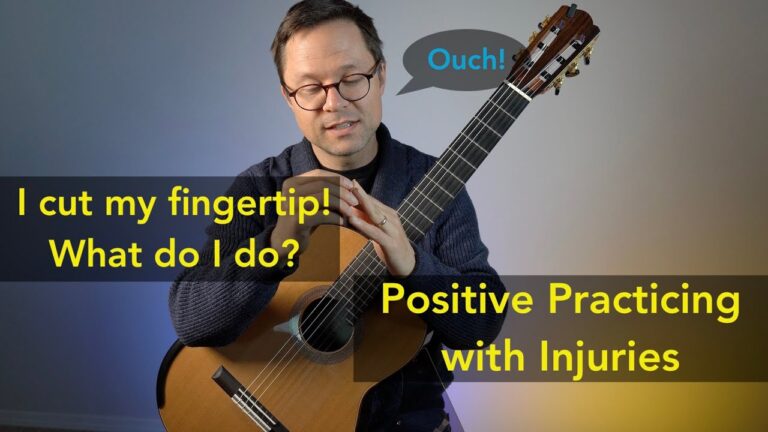
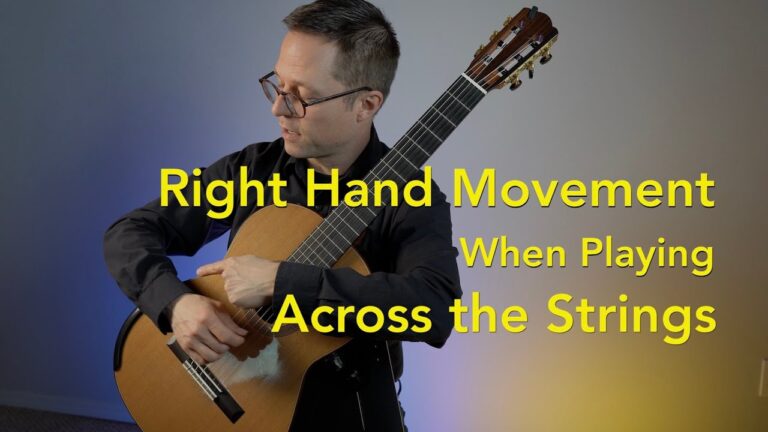
recommendations for reading stacked chord diagrams in guitar sheet music